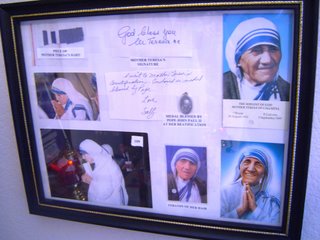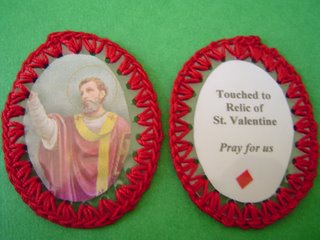Venerating Relics
(Some of the following is taken from the book Relics by Joan Carroll Cruz)
St. Jerome instructed that – “We do not worship relics and we do not adore them for fear that we will bow down to the creature rather than to the Creator, but we venerate the relics of the saints and martyrs in order to better adore Him whose martyrs and saints they are.”
St. Cyril of Alexandria wrote: “We by no means consider the martyrs to be gods, nor do we bow down before them in adoration, but only relatively and reverentially.”
After the death of Jesus, the persecution of the Christians brought about countless martyrs. They were buried secretly in the catacombs, which later became a treasury of relics for distribution. On the tombs of these heroic Christians religious services and Holy Mass were offered. As you walk through the many corridors of the catacombs you can see altars where the mass and martyrdom took place. Soon the possession of these saintly remains became an obsession. In order that no one person or group should be privileged above any other, the remains were divided. While many detest the very thought of disturbing the dead, these were not acts of desecration , but acts of veneration.
After 1313 when Constantine put an end to persecution of the Christians, the monuments built over the graves of the martyrs were transformed into sanctuaries and great basilicas. Churches were erected apart from the tombs of martyrs, the remains of one or the other of the martyrs were transferred and often enshrined within the altars. This was the beginning of the practice, of having relics of saints enclosed in a flat stone situated in the center of the altar directly beneath the spot where the Holy Sacrifice of the Mass is offered.
We do not know when the practice of venerating relics of the bodies of saints first began, but it was known during the fourth century. These small pieces of bone, for those who possessed them, were known to have a spiritual force that could produce miracles through the intercession of the saint to whom they belonged. They were enshrined at such great expense to the bearer of the relic. Pilgrims traveled great distances to these shrines to pray. When the possession of relics came to its full height during the Middle Ages, many churches owed their sanctity and renown simply to the presence of important relics.
With the increase in pilgrimages and processions to the churches that possessed outstanding relics, a rival town could improve its fortunes by acquiring a precious relic, sometimes by theft, thus transforming itself into a place of honor that deserved respect and attention. Eventually monasteries and parishes sought to increase their prestige by possession of treasured relics. Since the supply was naturally limited this often led to unfortunate rivalries. Few saints were allowed to rest in peace. Tombs were ransacked, the remains quarreled over, transferred from one church to another, and dismembered to be divided among numerous shrines. The securing and honoring of relics became so widespread that it was impossible to control competition or to prevent certain abuses, such as the distribution of fraudulent relics. Even today we must be very careful about fraudulent relics. When you obtain a first or second class relic be sure that the document accompanying it is an original and not a photocopy. Also most first and second class relic documents should have the raised seal attesting to its authenticity.
The vicar general of the Diocese of Rome has made the following statement:
“Relics should be handled intelligently and without abuses. They are signs which can be useful to spread devotion over the world. When relics are requested for private and public veneration they must be accompanied by official papers warranting their validity and authenticity. In no way may they be sold. A contribution may be requested merely to cover expenses such as for the relic case (the theca) and mailing charges.”
Several saints and holy persons have been given the grace to distinguish true relics from false relics. The Venerable Ann Catherine Emmerick could not only distinguish true from relics, but could identify their nature and origin. During her ecstasies, the stigmatist Therese Newmann could identify and describe true relics and distinguish these from false ones.
It should be noted that if a relic is false, the saint would still be honored since we do not pray to a bit of bone, but to the saint to whom it belongs.
The veneration of relics is permitted and encouraged by the Church out of honor for the bodies of the saints – which were temples of the Holy Spirit, and which will be raised to eternal glory – and to satisfy the universal instinct of mankind to treat with affection and reverence the material souvenirs of those we love. The Council of Trent added long ago that relics could be honored, since through them many benefits are granted to men by God. The Church has repeatedly warned, however, against the temptation to confuse sound spirituality with magic, blasphemous idolatry and superstitions.
Vatican II addressed the matter of relic veneration by noting that,
“The saints have been traditionally honored in the church and their authentic relics and images held in veneration. The Feasts of the saints proclaim the wonderful works of Christ in His servants, and display to the faithful fitting examples for their imitation.”
One last note – In 1995 I had the privilege of going to Italy and touring many of the churches that contained incorrupt bodies of the saints. In Venice we viewed the body of St. Lucy. The sacristan told us that several years ago, thieves came into the church and had everyone there lay face down on the floor. They stole the body of St. Lucy and only returned it when the ramsom was paid. They knew that the church would pay any amount to get the body of this renown saint back.
Also in Cascia, Italy, there lays the body of St. Rita. There are large iron bars between her body and the viewer. This also is because of thieves who were trying to steal the body in exchange for a ransom.
Labels: relics













